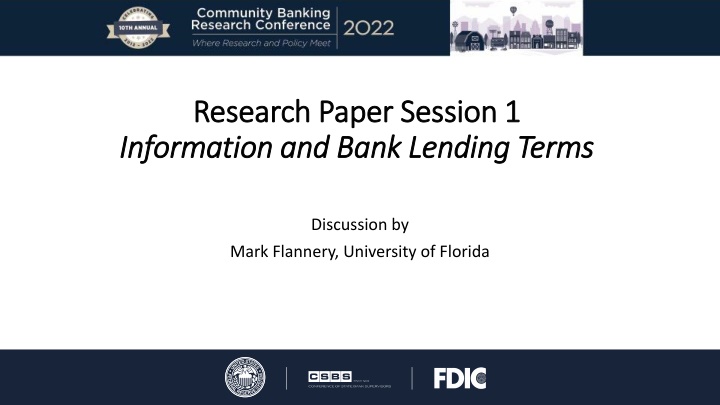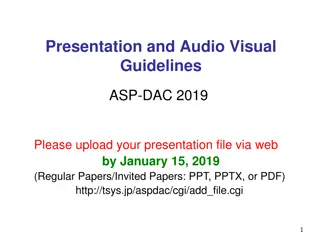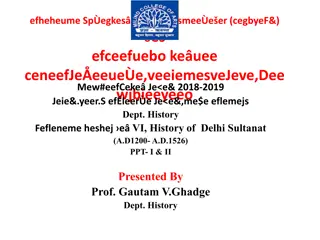
Insights into Information Usage in Bank Lending Practices
This research study delves into the significance of information in bank lending operations and explores various aspects such as bank monitoring with onsite inspections, relationship lending, and non-information asymmetry benefits. The analysis highlights the impact of inspection decisions on loan deals and advocates for examining loan rate regressions to understand the determinants of planned monitoring better. The study emphasizes the crucial role of information asymmetry in bank-firm relationships, as showcased through examples like the Payroll Protection Plan loans.
Download Presentation

Please find below an Image/Link to download the presentation.
The content on the website is provided AS IS for your information and personal use only. It may not be sold, licensed, or shared on other websites without obtaining consent from the author. If you encounter any issues during the download, it is possible that the publisher has removed the file from their server.
You are allowed to download the files provided on this website for personal or commercial use, subject to the condition that they are used lawfully. All files are the property of their respective owners.
The content on the website is provided AS IS for your information and personal use only. It may not be sold, licensed, or shared on other websites without obtaining consent from the author.
E N D
Presentation Transcript
Research Paper Session 1 Research Paper Session 1 Information and Bank Lending Terms Information and Bank Lending Terms Discussion by Mark Flannery, University of Florida
These three papers Look different in their topics and methods of analysis. But they all examine how information is used in bank lending. Obviously, crucial to academic and real-life bank operations.
Bank Monitoring with On-Site Inspections Awesome data as they say! Academics frequently talk about monitoring, o Without any data o With varying conceptions of what it means
Lots of interesting connections between performance and monitoring. o More inspections for larger, longer, and riskier loans. Table 3. o Past interactions reduce inspections relationship information? o More inspections reduce defaults. o Language affects draws; proof of relevance of these inspections.
While I enjoyed seeing all these things documented really, for the first time I kept wondering how inspections decisions interact with other elements of the loan deal. Stock analysts: who should a new entrant choose to follow? Joint determination of rate, fees, amounts, collateral, and now inspections. Difficult statistical problem, but with these data I suggest they try to tackle it. How?
Estimate loan rate regressions with inspection frequency as an explanatory variable. o Already have an instrumental variable for inspections. Show some more of the estimated coefficients on loan features, to help understand determinants of planned monitoring. o Table 3 includes some interesting risk measures, which are not reported in later tables. o It would be good to see how (if) the coefficients on risk measures vary when we add information on Past relationships (in Table 4) Selected other borrower characteristics (Table 8), or with borrower and contractor fixed effects (in Table 10)
Non-Information Asymmetry Benefits of Relationship Lending Relationship lending is a major subject of analysis in the banking literature. Thought to provide banks with valuable PRIVATE information. This information asymmetry between past and potential new lenders affects competition for business. o Often presented as generating forebearance if a firm encounters trouble in the future. This paper uses Payroll Protection Plan loans to demonstrate the relevance of information asymmetry in bank-firm relationships.
Conclusions: o Repeat borrowers are processed more rapidly. o The bank might even lie for a borrower who falls outside PPP guidelines. o Past deposits do not significantly affect processing speed. BUT, what does this have to do with asymmetric information and the bank s inclination to forebear in the future? PPP loans fully guaranteed. These firms were in pretty bad shape and deteriorating AND the bank had loans outstanding to such firms.
Rushing through PPP applications means that the government makes your existing loans safer! The evidence is consistent with the evergreening mechanism where banks keep unprofitable firms alive I find the presented results interesting, but o I don t see the relevance of this conclusion to the information asymmetry motivation. o Exposition needs some more work.
Bank Loan Markups and Adverse Selection I smiled when I had read enough of this paper to see what it is about. Great idea! Franklin National Bank, failed in 1973. o Had recently moved from Long Island into Manhattan o Set about expanding their commercial loan portfolio o WSJ story o Groucho Marx
The Concept More competitors should make any one lender expect a higher PD if their loan offer is accepted. More competitors more opportunities for there to be negative information known to one of them That is, the more serious is the winner s curse.
Loan rate markup Risk-adjusted
I believe the story, at least in its broad outline. Two estimation issues: Contradictory estimates? Tables 5 and 6 both explain Risk-Adjusted markups. Estimated coefficient on One Bank is significantly positive in Table 5. Same coefficient is significantly negative in Table 6, when include fixed effects. WHY? Are markups computed from an inappropriate regression specification? Estimating markups from a regression of loan rate on firm and deal characteristics (Table 3). o Fails to recognize an important constraint: that the loan rate will never be below the riskless rate. (Implied spread must be positive.) o Instead, estimate the Spread as depending on firm and deal characteristics. Make a difference?
Some suggestions for further confirmation. Compute the theoretical effect of random noise on the probability of offering the lowest loan rate in any given group size. Compare to slope in Figure 2. Cut the larger loans out of the sample, expecting to see more dramatic effects. Think about MSAs as geographical unit, rather than counties.
Three nice papers Tell us some interesting things about information in bank models






















